Postagens longas no WordPress podem ser difíceis de ler. Como compartilhar conteúdo detalhado sem perder o interesse dos leitores?
A resposta é a paginação de postagens, que significa dividir uma postagem longa em várias páginas mais curtas. Usamos esse método para dividir grandes guias e longos tutoriais em alguns de nossos projetos de blog. Em todas as vezes, notamos que os leitores se envolveram mais com o conteúdo.
Neste guia, mostraremos como dividir suas postagens do WordPress em várias páginas. Abordaremos métodos fáceis, com e sem um plug-in.
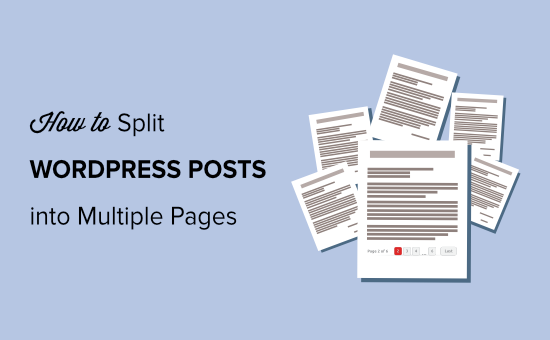
Por que dividir os posts do WordPress em várias páginas?
Se você tiver postagens de blog ou guias do WordPress que sejam longos, a configuração da paginação do WordPress poderá melhorar a legibilidade do conteúdo.
Isso ajuda a dividir uma postagem longa em diferentes seções e dividi-las em várias páginas. Dessa forma, os visitantes podem digerir facilmente o conteúdo e ler qualquer seção de seu interesse.
Outro benefício da divisão de posts do WordPress é que ela pode aumentar o envolvimento do usuário. Quando os usuários navegam pelo conteúdo paginado, cada página que eles visualizam contribui para aumentar as visualizações de página, o que pode afetar positivamente as métricas gerais do seu site.
Dito isso, vamos dar uma olhada em como dividir as postagens do WordPress em várias páginas. Abordaremos como dividir suas postagens do WordPress em várias páginas sem um plug-in e usando um plug-in do WordPress:
- Método 1. Dividir uma postagem do WordPress em várias páginas sem um plug-in
- Método 2. Dividir vários posts do WordPress em várias páginas usando um plug-in
Método 1: Dividir um único post em várias páginas sem um plug-in
A maneira mais fácil de configurar a paginação de posts é usar o bloco “Page Break” no editor de blocos do WordPress. Você não precisa de um plug-in do WordPress para dividir seus artigos em várias páginas.
Primeiro, você precisa editar ou adicionar uma nova postagem em seu site WordPress usando o editor de blocos Gutenberg.
Depois disso, clique no botão “+” onde deseja dividir o conteúdo e adicione um bloco de quebra de página.
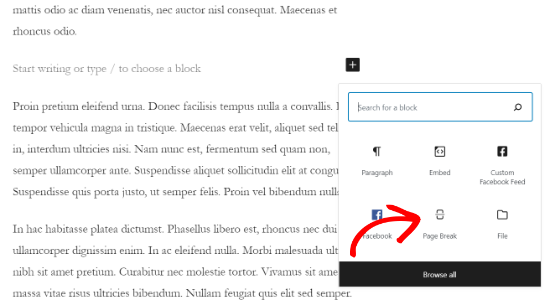
Agora você deve ver uma linha de quebra de página em seu conteúdo para indicar onde a paginação aparecerá.
Ele terá a seguinte aparência.
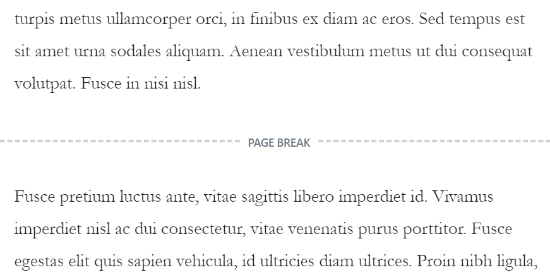
Se você estiver usando o antigo editor clássico, poderá usar a tag <!--nextpage--> para dividir o conteúdo.
Ao escrever uma postagem de blog, basta acessar a visualização do editor de “Texto” para inserir a tag em que você gostaria de dividir o artigo longo.
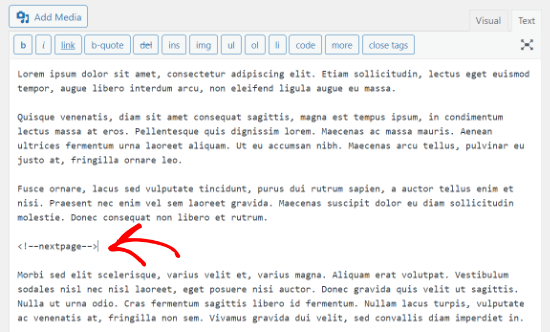
Você também pode usar as teclas Alt + Shift + P do teclado para inserir quebras de página. Para fazer isso, vá para a visualização “Visual” e pressione as teclas de atalho do teclado onde deseja adicionar uma quebra de página.
Depois disso, você pode visualizar e publicar a postagem do blog. Agora você verá a paginação do post na parte inferior do conteúdo do post.
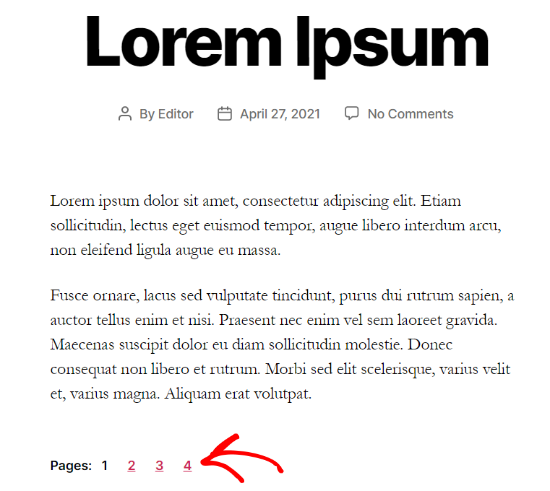
Método 2: Dividir vários posts do WordPress em várias páginas usando um plug-in
Outra maneira de dividir um conteúdo extenso em várias páginas é usar um plug-in de paginação. A vantagem desse método é que ele paginará automaticamente as postagens quando elas atenderem a determinados critérios.
Para esse método, usaremos o plug-in gratuito Automatically Paginate Posts, pois ele é fácil de usar e funciona com qualquer tema do WordPress.
Observação: você pode notar que esse plug-in não foi testado com as versões mais recentes do WordPress. No entanto, nós mesmos o testamos e ele funciona melhor do que todos os plug-ins que verificamos.
Você pode ler mais sobre se deve usar plug-ins não testados do WordPress em nosso artigo. Se você encontrar um plug-in que funcione melhor do que o que oferecemos, sinta-se à vontade para nos informar nos comentários abaixo!
Primeiro, você precisa instalar e ativar o plug-in Automatically Paginate Posts em seu site do WordPress. Para obter mais detalhes, consulte nosso tutorial sobre como instalar um plug-in do WordPress.
Quando o plug-in estiver ativo em seu site, vá para Settings ” Reading (Configurações ” Leitura ) e role para baixo até a seção “Automatically Paginate Posts” (Paginar automaticamente as publicações).
Você pode selecionar os tipos de post a serem divididos em páginas diferentes. Depois disso, escolha se deseja dividir as postagens pelo número total de páginas ou pelo número aproximado de palavras por página.
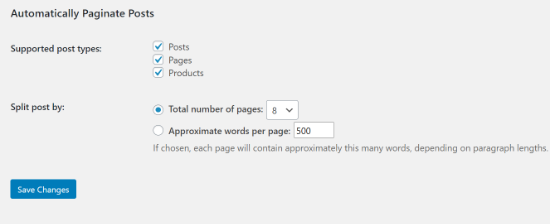
Em seguida, clique no botão “Save Changes” (Salvar alterações) para armazenar suas configurações.
O plug-in dividirá automaticamente seu conteúdo com base em suas configurações. No entanto, você também pode adicionar quebras de página manualmente ao seu conteúdo enquanto usa o plug-in.
Dica bônus: Use o AIOSEO para otimizar a paginação de suas postagens
Paginar sua postagem longa pode definitivamente melhorar a experiência do usuário. Dito isso, é importante que você configure a postagem adequadamente para que ela não afete negativamente o SEO (otimização para mecanismos de pesquisa) do seu site.
Se um post de blog estiver distribuído em várias páginas devido à paginação, o Googlebot poderá acabar indexando várias cópias do mesmo conteúdo. Isso pode levar a problemas de conteúdo duplicado.
Felizmente, você pode evitar isso usando o plug-in All in One SEO (AIOSEO). Esse plug-in de SEO para WordPress facilita a otimização do SEO do seu site, mesmo que você não tenha conhecimento técnico.
O AIOSEO insere automaticamente um número de página no título de SEO do conteúdo paginado. Dessa forma, os mecanismos de pesquisa podem entender que a postagem foi distribuída em várias páginas e não é uma duplicata de outra postagem.
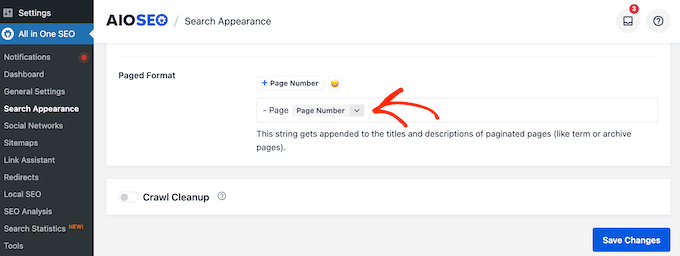
Além disso, o AIOSEO removerá esses números de página dos URLs de suas páginas de postagem. Ao fazer isso, os mecanismos de pesquisa saberão qual é a página principal da postagem do blog que eles devem classificar para as palavras-chave relevantes e que os usuários devem ver primeiro.
Ele faz isso ativando automaticamente a configuração “No Pagination for Canonical URLs” (Sem paginação para URLs canônicos).
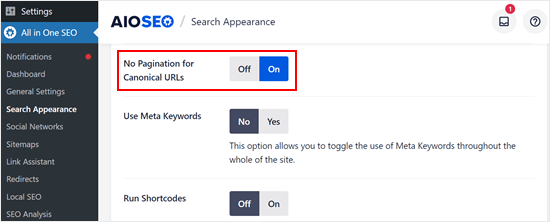
Para obter mais informações sobre o AIOSEO, consulte nosso artigo sobre como configurar o AIOSEO para WordPress.
Mais dicas para gerenciar conteúdo longo no WordPress
Dividir posts em páginas é apenas uma maneira de lidar com conteúdo longo. Aqui estão algumas outras técnicas úteis que consideramos úteis:
- As dicas de ferramentas são ótimas para adicionar detalhes extras sem sobrecarregar o conteúdo principal. Elas aparecem quando os leitores passam o mouse sobre determinadas palavras.
- Mantenha os leitores envolvidos mostrando a eles conteúdo relacionado bem no meio de suas postagens.
- Se você tiver um tópico extenso a ser abordado, considere a possibilidade de criar uma série de posts em vez de escrever um longo post de blog sobre ele. Isso ajuda os leitores a acompanhar o assunto com facilidade.
- O título da postagem geralmente é um único cabeçalho, mas você pode dividi-lo em uma nova linha se for muito longo para torná-lo mais legível.
Esperamos que este artigo tenha ajudado você a aprender como dividir as postagens do WordPress em várias páginas. Talvez você também queira ver nosso guia sobre como adicionar um botão de carregar mais nas postagens do WordPress e nossas escolhas de especialistas sobre o melhor plug-in de postagens relacionadas no WordPress.
Se você gostou deste artigo, inscreva-se em nosso canal do YouTube para receber tutoriais em vídeo sobre o WordPress. Você também pode nos encontrar no Twitter e no Facebook.





Jiří Vaněk
From the point of view of seo, is it better to write one long article or divide it like this and more pages? It seems to me that a long one is better from a point of view, but maybe you have other experiences?
WPBeginner Support
It heavily depends on the content and how the pagination is used but pagination should be used more for readability than SEO.
Admin
Jiří Vaněk
Thank you for answer. I know that in the past it was done very often. The user may not be afraid of a large amount of text. Personally, I’m afraid that the robot will leave the site without visiting the others, and I prefer not to do this technique and try to break up the text with graphics. Anyway, thanks for the response
Dapo
Thank you for this post. Unfortunately, this does not show anything on the frontend.
WPBeginner Support
If pagination is not working for your site, there is a chance that your theme does not allow pagination. In these cases we recommend checking with the support for your specific theme and they can normally help
Admin
Wahyu
I follow this tutorial and working fine. But i have some issue, when i click pagination on page 1 or 2 everything is going fine, but when i’m going to the last page in this case is page 3, my layout structure under pagination like a related post, comments and right sidebar are broken so my website looks ugly on thoose parts. Any suggestion related this issue?.
WPBeginner Support
You would want to reach out to the support for your specific theme and let them know about that formatting error and they should be able to assist
Admin
pankaj
can i change nextpage name
example:
name. com/love/1/
to
name . com/love/hello
WPBeginner Support
For what it seems like you’re wanting, you would want to look at changing your permalinks: https://www.wpbeginner.com/wp-tutorials/how-to-create-custom-permalinks-in-wordpress/
Admin
Al Hasan
Thanks for the tutorial, I want ask, Can I make infinite scroll on this multiple pages ?
thanks
WPBeginner Support
You would want to reach out to what you are using to set up the infinite scroll for how it handles post pagination.
Admin
Hosam
Thanks for This tut but we want to know how to make pagination for posts as we can see on your blog category not for the articles itself only
Chris
Hi guys,
may it be that this doesn’t work when using the Divi theme?
I tried, but nothing happens…
Thanks!
Dave
Your link for “two pages” goes to http://list25.com/25-hilarious-siri-responses/ and your link for “five pages” goes to http://list25.com/25-epic-fail-gifs/ … did your site get hacked or are these misleading ad links that you’re getting paid for?
WPBeginner Support
Hi Dave,
These are not misleading links. We own list25 website and they are linked in reference to show users example of how Post Pagination is used. List25 uses it to display a post on two pages and fives pages.
Admin
Lauro Carvalho
Very simple and useful! I was really looking for this. Much appreciated!
suzanne ball
That part works fine but I can’t get my title for the 2nd page to take the “/2/” so the wonderful pagination you just showed takes you TO the 2nd page
Ankit
Hello,
Thank you for this tutorial, it is helpful!
Though I want to know what to do if I want a button directing to next page of the same post, instead of 1,2,3… page number below?
How can I do that?
Rhonda
My theme is DIVI and I tried the alt, shift and p option and instead it displayed the following symbol inside worpdress editor:
∏
Its for a post and I do not use the DIVI BUILDER for posts.
Why did it not work?
Nrusingh
Sir/Madam,
Thanks for helping me many times, and I am stuck once again.
I want pagination on a page not posts. I have a page with 30 thumbnails with different page links. So, I want to paginate them into 3 pages with 12 (4 rows x 3 columns) thumbnails each. Is there a way?
Thanks In Advance
Have a nice day ahead
Shiraz
It works for me, but with some layout issue. The pagination buttons are not in same row.
Darius Spearman
Awesome…except no pagination is showing at the bottom and I don’t know what a “single.php loop” is. Can someone explain what that is and to add something to it?
Jos Mwangi
Thank you guys for this guide, I have been trying to do this the whole day! But I have a quick question though, is it possible to make the introduction appear on every page of the blog post? Like making it “sticky” at the top of every sub-page.
Jordan Ring
Thank you for the help! Spent over an hour trying to figure this out with the Divi theme. The Alt Shift P did the trick! Finally!
waqastaqee
thanks alot. thus was vary helpful. i was trying for hours but don’t get it.
“alt+ shift+ p” done
Joseph Chotard
Thank you,
This is helped me a lot as I had no idea how to create multiple pages.
Wenda
Thank you. I can’t tell you how much I appreciate this instruction. PERFECT! Thank you thank you thank you! I was thinking I’d need a plugin or theme change and well… you just solved in under 3 minutes something that I’ve already spent like 30 minutes trying to figure out! THANK YOU!
WPBeginner Support
Hi Wenda,
We are glad you found this article helpful. You may also want to subscribe to our YouTube Channel for WordPress video tutorials.
Admin
Regel Javines
I have a Twenty Ten theme of my blog
Now, ALT+SHIFT+P works for my well. However, it appears super below the post that it takes the reader to scroll down to see the 2nd page.
How can I let it appear right after the end page of the post to avoid scrolling down. And, is there any code for a button NEXT, PREVIOUS page instead of Page 1, 2? Please help…
Aizal
Thanks for this. Although need to ask, is there any plugin or code to make the pagination to appear as buttons?
Dankasaurus
Not sure if there’s a plugin but normally you would have to modify that with CSS.
Enrique
Sorry if this is stupid, but if you copy and paste the from this article, it won’t work. The dashes are different from what they should be. You have to type it directly in your editor. I copied this and it didn’t work until I typed it with the correct dashes.
Enrique
The comments system removed a word. What I meant is
“…If you copy and paste the “nextpage” from this article…”
André Quintão
Thanks, you saved me a lot of trouble. Cheers!
Cheers!
Kareem
Thank you!!!
Simo
Hello, I had to modify the single.php but rarely it worked on the last post where I did the modification and wrote sorry i don’t remember now exactly the shortcode, but when I introduced the short code in other posts it didn’t work and it appear on the post he shortode..
So, firsly it didn’t work so I tryed it on a post, then I modified the single.php and then it worked , probably later i did some modification on the single.php, and i tryed the shortcode on other post without outcome, but still working on the frst post i modified… it’ very strange why it work on a post and not on others?
May cache doing some “joke”
Thank You.
Kuen
I was going through this article how you customized the theme for list25 ( https://www.wpbeginner.com/wp-tutorials/case-study-behind-the-scenes-look-of-list25-plugins-and-hacks/comment-page-1/#comment-338067 )..
List 25 uses custom editor layout and first part of it is the “List Description” which is fixed throughout the post.. How can i do that?
sudhir k Gupta
Cont..
I am using Masonic theme
Vikas Kumar
I don’t like to use plugins for this.
So i am using above code to pagination wordpress post.
It looks like text link (Page: 1 2 3 4 5.. 10) but i want to show this in Advanced Buttons. (Advanced Post Pagination plugin provide only for Pro user.)
Please tell me how may i change Post pagination links in Advance Buttons using CSS or JS.
Bidyot
Dear Sir,
Thanks a lot. We have successfully add single post pagination as per your suggestion.
But we are facing another problem.
Pagination is displaying after our related posts display.
How can we display pagination above the related posts column.
Any help highly appreciated.
WPBeginner Support
For that you may need to edit your WordPress theme or settings of your related posts plugin. If your related posts plugin automatically adds related posts, then you need to contact plugin support to learn how you can delay it so that post pagination is shown first. If your related posts plugin provides a template tag, then you need to add that tag into your theme’s single.php or content-single or content.php template after the the_content() tag in the code.
Admin
Robert Dany
Why do I get duplicate content in google webmaster tools after splitting a blog post to 3 pages? And how to prevent this?
Bora Kurekci
The recommended solution of “Alt+Shift+p” gorgeously worked for the theme SemPress on my blog.
Thank you so much
Anthony Franck
This is really cool and it worked, kind of. The page numbers are super ugly and there is a “glaring inconsistency”.
I did see that your demo site list25 has beautiful red squares, I was wondering how you went ahead and created the nice squares?
Would it be possible to make a demo for that and send us the link?
Also About halfway through my setting this up on my website it struggles to handle the page breaks. They are all there but putting 12 jpegs between 12 page breaks freezes up my website and it won’t allow me to load anymore images on the post. Has anyone had any issues with this crashing the database? Thanks in advance for any help
WPBeginner Support
You can see the List25 CSS by right clicking on the page navigation and select Inspect from browser menu.
Admin
Dave
I’d just like to say, before anyone clicks the link in this comment, it is NSFW.
Now, on to my question.
Here is the page I want to split into multiple:
My problem is, there are around 80+ posts on that page already. How can I manually add a next page/next post/more to the page so that it can be split into multiple pages, instead of showing every single post and every single image on 1 page?
It makes it awful inconvenient. It also forces the page to take forever to load. Try it out yourself. See how long it takes to load.
Can anyone assist? What WP code can I use to break the page up? Everything I see mentions “posts” and not “pages”, unfortunately.
WPBeginner Support
Your WordPress theme should automatically handle this. It seems like either your plugin or a plugin you are using is lazy loading or pre-loading all the posts. Visit Settings » Reading page. There you can select how many posts you want to show on your blog pages. If it is already set at 10 or less, then this means you should check your plugin and themes. If it is set to a much higher number then you can change that here and save your settings.
Admin
apachx
Whenever, I insert the nextpage tag in the HTML of the post I get the page number at the bottom of the post area. But, the problem is that some other plugins like author box and wordpress related posts are being shown before the page numbering which makes it invisible to readers.
Is there any way to put the page numbering just below the post area e.g. below adsense link unit in the post area?
me
Very Bad idea
user really hate to click 1 – 9 and 9- 1 just to read it
u maybe think about How to Increase Pageviews and Reduce Bounce Rate
but user will just close the tab
Dyc3r
You can use “Next/Previous” instead of page numbers with the following:
`wp_paginate_links( array( “next_or_number” => “next” ) );`
Incidentally, this is my biggest issue with the core function. There’s a glaring inconsistency between `paginate_links()` and `wp_link_pages()` in that the latter forces you to choose between numbers and next/previous.
Granted, since this is designed to flip between pages of a single post versus pages of an “archive”, the number of available pages will (or should) be relatively low, but it would be nice to have a little more flexibility similar to what we get with archive pagination
besty
Nice post, it worked for me but how do i make the Next Page appear immediately after the post instead of after the related post? what i mean is that my site related Posts showing before the Next Page Link.
How can you help?
thanks
Mantas
Same problem here. Does anyone knows solutions to this problem?
Stephen Pate
That appears on my site and looks like Jetpack features get ahead of the pagination.
Val Archer
Hi – I’m using index.php for my posts which are all one-per-page. doesn’t work for me, so I added just below the loop in index.php but it still doesn’t work. So I saved index.php as single.php because you mention “you would need to add the following code in your single.php loop.” So I figured maybe it works only in single.php but not in index.php?
But now I can’t find where to tell wordpress to use single.php as the template for blog posts! I have a static front page. The page “Posts — Posts Page” does not give the option of choosing a template. Somehow once upon a time I told it to use the “Template Name: IndexMine” for posts. But I don’t know how or where!
Please can you tell me how I can tell wordpress to use single.php for blog posts? Then hopefully will work? Thank you!
Dyc3r
If I understand your issue correctly, you’re actually using this function in the wrong place. Think of your site like a library/bookstore where each post is a book.
— `posts_per_page` determines how many books you put on a shelf.
— `wp_link_pages()` will turn the page in the book you are currently reading
— `paginate_links()` will move to a new shelf
It sounds like you want to move to a new shelf, in which case, `paginate_links()` is the function you need
Maran
I was thinking if there a way to do it. You guys rock. I am glad that I am following on twitter.
Ali
My website contains long post and used to split them into multiple pages using ALT+SHIFT+P and this works well on my desktop theme, but when I installed WPtouch plugin I see 1 2 3 pages and when I click on any of them it reloads page no 1 .
How can i fix this problem ?
WPBeginner Support
Please contact WPTouch support.
Admin
James
But I also dont want to index 2nd and 3rd page and how to solve pagination in wordpress.
Brent
What if you have a featured image and only want it to show on the first page but not on pages 2, 3, 4, etc.?
Brent
Anyone have an answer?
Shubham Mundra
I am using MH Magzine Pro theme. When I put the nextpage tag between the article it only shows 123…. number. I want to do it like this Pre 1 2 3 Next. Is this possible?
John
“If for some reason, pagination is not showing up after you have pasted the next page tags, then you would need to add the following code in your single.php loop.”
What code?
WPBeginner Support
Thanks for notifying us. We have updated the article.
Admin
Aaron
nope not working at all for me… ugghhhhhh whyyyyyyy
Agung
Maybe not supported on your theme
maik
How to invert the pagination, I want create a page and spliting in multiples pages to show the recent posts? : This mode: 3, 2, 1. and no Pages 1, 2, 3.
semmy
Hi thank you very much for your tutorial. It’s work, oh ya I want to ask something about adsense, how we can add adsense below multiple pages, can you create a tutorial for that one? many thanks
Edwin
Thanks for the tip, I’ve recently tried this, and the pagination shows up correctly, but when clicking the links (2,3,4,etc.), i get a page not found error. Do you have any idea what would cause that?
Ricardo Cury
You might want to check you Permanent Links Structure.
Edmond
Hi,
Can you please do a tutorial on how to create the “view all” function too, as it’s really very useful. I’ve seen a similar thing here: http://list25.com/25-most-expensive-private-jets-ever-made/ (http://list25.com/25-most-expensive-private-jets-ever-made/?view=all)
Thanks!
Edmond
Hi,
Really love the feature of splitting pages. I also see that you have the “View All” option on list25.com. How can I add that same feature to my website? I’d really love to see a tutorial for this too.
João Paulo Porto
i have the same question
João Paulo Porto
If for some reason, pagination is not showing up after you have pasted the next page tags, then you would need to add the following code in your single.php loop.
Which code are you talking about? I really need this code.
Lester
Olá João Paulo,
Have you noticed how to manage pagination on wordpress long posts? This thread is not really helpful. I´m using wp 2.2.2 and I´m looking for splitting long posts in 1,2,3,4…view all pages too !
WPBeginner Staff
See how to add numeric pagination to WordPress themes.